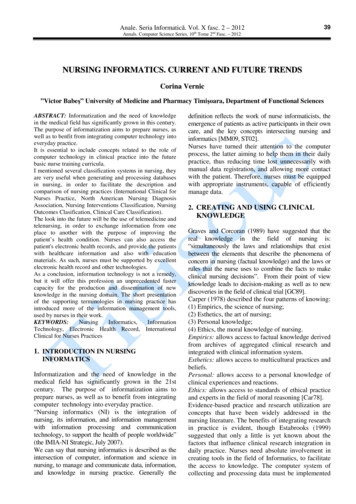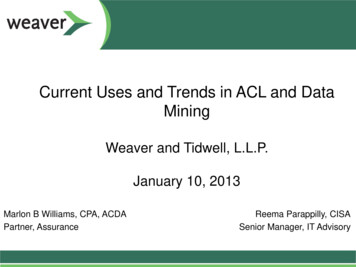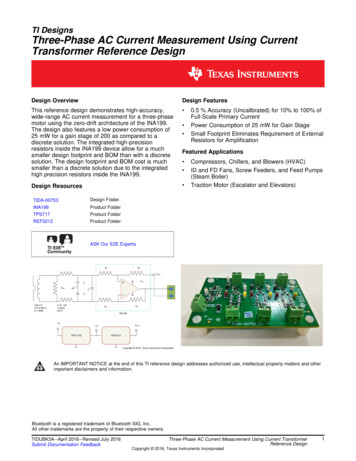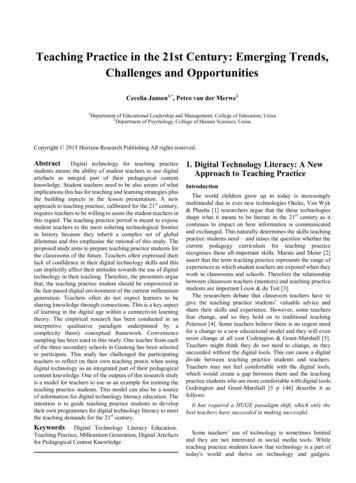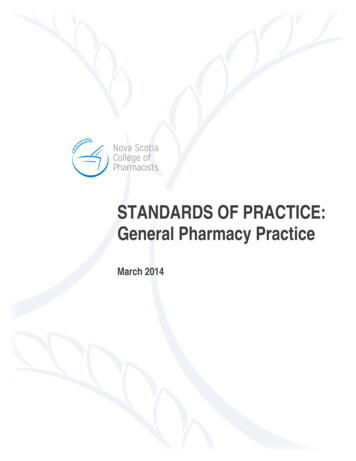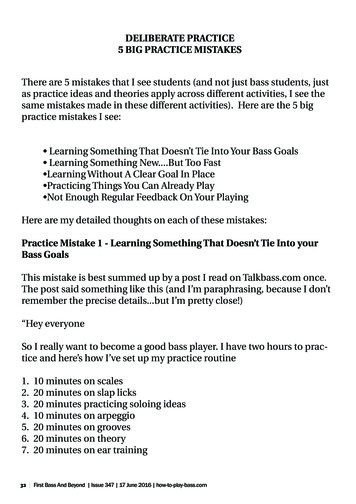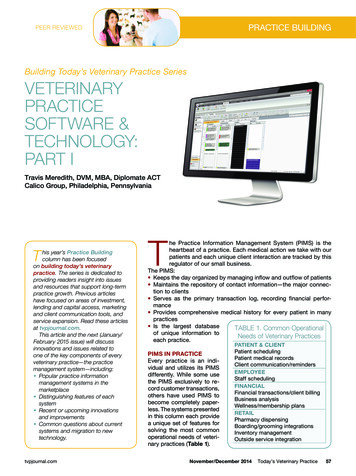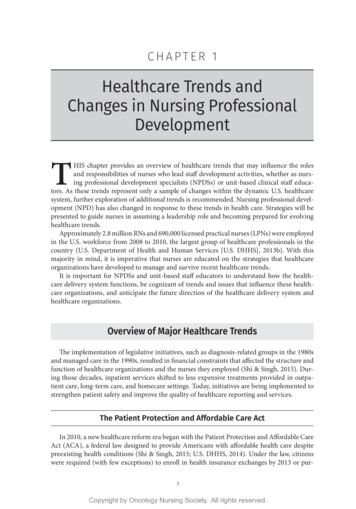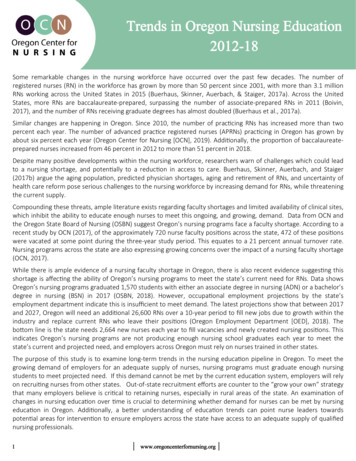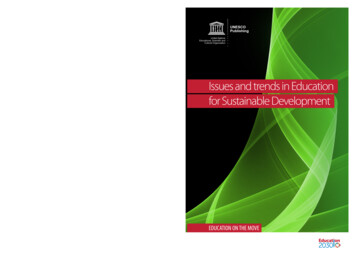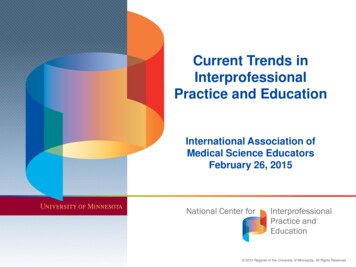
Transcription
Current Trends inInterprofessionalPractice and EducationInternational Association ofMedical Science EducatorsFebruary 26, 20151The National Center for Interprofessional Practice and Education is supported by a Health Resources and Services Administration 2013RegentstheUniversityUniversityof Minnesota,Rights ReservedCooperative Agreement Award No. UE5HP25067. 2013Regents ofof theof Minnesota,All RightsAllReserved.
Topics Interprofessional education and the link to collaborativepractice, or interprofessional practice and education (IPE) History and background of IPE and CP What has stimulated renewed interest in IPE in the US andglobally?2The National Center for Interprofessional Practice and Education is supported by a Health Resources and Services AdministrationCooperative Agreement Award No. UE5HP25067. 2013 Regents of the University of Minnesota, All Rights Reserved.
The National Center:A New Model for Public-Private PartnershipThe National Center for Interprofessional Practice and Education issupported by a Health Resources and Services Administration 4M,five year Cooperative Agreement Award No. UE5HP25067.In addition, the Josiah Macy Jr. Foundation, the Robert Wood JohnsonFoundation (RWJF), and the Gordon and Betty Moore Foundationhave collectively committed funding in grants over five years to supportand guide the center, which provides leadership, scholarship, evidence,coordination and national visibility to advance interprofessional educationand practice as a viable and efficient health care delivery model.3The National Center for Interprofessional Practice and Education is supported by a Health Resources and Services AdministrationCooperative Agreement Award No. UE5HP25067. 2013 Regents of the University of Minnesota, All Rights Reserved.
Funder Perspectives4The National Center for Interprofessional Practice and Education is supported by a Health Resources and Services AdministrationCooperative Agreement Award No. UE5HP25067. 2013 Regents of the University of Minnesota, All Rights Reserved.
HRSA PrinciplesJune 1, 2012 Funding Opportunity AnnouncementA coordinating center for interprofessionaleducation and collaborative practice willprovide leadership, scholarship, evidence,coordination and national visibility toadvance interprofessional education andpractice as a viable and efficient health caredelivery model.5 2013 Regents of the University of Minnesota, All Rights ReservedThe National Center for Interprofessional Practice and Education is supported by a Health Resources and Services Administration 2013RegentstheUniversityUniversityof Minnesota,Rights ReservedCooperative Agreement Award No. UE5HP25067. 2013Regents ofof theof Minnesota,All RightsAllReserved.
Points to ponderWhat is “interprofessional education andcollaborative practice”?What are your experiences with IPECP?Why should we care about IPECP?6The National Center for Interprofessional Practice and Education is supported by a Health Resources and Services AdministrationCooperative Agreement Award No. UE5HP25067. 2013 Regents of the University of Minnesota, All Rights Reserved.
7The National Center for Interprofessional Practice and Education is supported by a Health Resources and Services AdministrationCooperative Agreement Award No. UE5HP25067. 2013 Regents of the University of Minnesota, All Rights Reserved.
What is not IPE: Shared LearningPharmacyNursingOTMedicine8The National Center for Interprofessional Practice and Education is supported by a Health Resources and Services Administration 2013RegentstheUniversityUniversityof Minnesota,Rights ReservedCooperative Agreement Award No. UE5HP25067. 2013Regents ofof theof Minnesota,All RightsAllReserved.
Interprofessional Education andCollaborative PracticeInterprofessional education (“IPE”) “occurs when two ormore professions learn with, about, and from each other toenable effective collaboration and improve health outcomes.”Interprofessional (or collaborative) care “occurs whenmultiple health workers from different professionalbackgrounds provide comprehensive health services byworking with patients, their families, carers (caregivers), andcommunities to deliver the highest quality of care acrosssettings.”Framework for Action on Interprofessional Education and Collaborative Practice, WHO 2010.9The National Center for Interprofessional Practice and Education is supported by a Health Resources and Services Administration 2013RegentstheUniversityUniversityof Minnesota,Rights ReservedCooperative Agreement Award No. UE5HP25067. 2013Regents ofof theof Minnesota,All RightsAllReserved.
IPE Pedagogy / Andragogy Strategies focused on how adults learn Interactive and learning in interprofessionalgroups Collaborative learning Facilitated learning – roles for mentors Reflective learning Ideally, problem focused and related tocollaborative practice Role of simulations Cognitive science and learning theory10The National Center for Interprofessional Practice and Education is supported by a Health Resources and Services AdministrationCooperative Agreement Award No. UE5HP25067. 2013 Regents of the University of Minnesota, All Rights Reserved.
Welcome to the 40-Year Old “New” Field11The National Center for Interprofessional Practice and Education is supported by a Health Resources and Services AdministrationCooperative Agreement Award No. UE5HP25067. 2013 Regents of the University of Minnesota, All Rights Reserved.
12The National Center for Interprofessional Practice and Education is supported by a Health Resources and Services AdministrationCooperative Agreement Award No. UE5HP25067. 2013 Regents of the University of Minnesota, All Rights Reserved.
Dr. Dewitt “Bud” Baldwin’s ACGME Office13The National Center for Interprofessional Practice and Education is supported by a Health Resources and Services AdministrationCooperative Agreement Award No. UE5HP25067. 2013 Regents of the University of Minnesota, All Rights Reserved.
Cycles of interest in IP Teams Rehabilitation Mental health Comprehensive care in chronic illness Primary care Rural health Geriatrics Hospice and palliative care Renal teams Intensive care Transplant teams14The National Center for Interprofessional Practice and Education is supported by a Health Resources and Services AdministrationCooperative Agreement Award No. UE5HP25067. 2013 Regents of the University of Minnesota, All Rights Reserved.
In the US, 1970s – 2000: Lack of Broad Support “Status” of primary care and underserved populations –not a locus of power in Medicine Era of specialization and sub-specialization Little interest in care delivery processes New roles and controversies: Nurse practitioners,physician assistants, clinical pharmacists Lack of evidence for team-based outcomes Lack of incentives: physicians reimbursed; teams and/orother professionals rarely Considerable independent work15The National Center for Interprofessional Practice and Education is supported by a Health Resources and Services AdministrationCooperative Agreement Award No. UE5HP25067. 2013 Regents of the University of Minnesota, All Rights Reserved.
Global Resurgence for IPECP16The National Center for Interprofessional Practice and Education is supported by a Health Resources and Services AdministrationCooperative Agreement Award No. UE5HP25067. 2013 Regents of the University of Minnesota, All Rights Reserved.
17The National Center for Interprofessional Practice and Education is supported by a Health Resources and Services AdministrationCooperative Agreement Award No. UE5HP25067. 2013 Regents of the University of Minnesota, All Rights Reserved.
Global Background and Resurgence1987:Centre for the Advancement of Interprofessional Education (UK)1997:All Together Better Health conferences1999- 2003: IOM Triology2003-4:Health Canada investments2005:Canadian Interprofessional Health Collaborative2007:Collaborating Across Borders conferences2010:WHO Framework for Action, IPEC Competences (US), and the“Lancet” Report2012:Institute of Medicine Global Forum2012:National Center for Interprofessional Education2012:Global Research Interprofessional Network2014:World Coordinating Committee(AIHC, AIPPEN, CAIPE, CIHC, EIPEN, JAIPE & JIPWEN, NIPNET)18The National Center for Interprofessional Practice and Education is supported by a Health Resources and Services AdministrationCooperative Agreement Award No. UE5HP25067. 2013 Regents of the University of Minnesota, All Rights Reserved.
19The National Center for Interprofessional Practice and Education is supported by a Health Resources and Services AdministrationCooperative Agreement Award No. UE5HP25067. 2013 Regents of the University of Minnesota, All Rights Reserved.
Current US interest Institute for Healthcare Improvement “Triple Aim”oooImproving the patient experience of care;Improving the health of populations; andReducing the per capita cost of health care. Collaborative practice and care coordination Quality, patient safety and systems improvement Patient Protection & Affordable Care Act New payment and care delivery models New defined competencies ACME, LCME and other accreditation expectations Patients, families and communities20The National Center for Interprofessional Practice and Education is supported by a Health Resources and Services Administration 2013RegentstheUniversityUniversityof Minnesota,Rights ReservedCooperative Agreement Award No. UE5HP25067. 2013Regents ofof theof Minnesota,All RightsAllReserved.
The US IPE scene since 201021The National Center for Interprofessional Practice and Education is supported by a Health Resources and Services AdministrationCooperative Agreement Award No. UE5HP25067. 2013 Regents of the University of Minnesota, All Rights Reserved.
IPECCompetencies Values & ethics forinterprofessional practice Roles & responsibilities Interprofessionalcommunication Teams and teamworkOther NeededCompetencies Population health, including socialdeterminants Patient-center decision-making Evidence-based decision-making Cost-effective practices Quality improvement and safe practice Stewardship Systems thinking Informatics22The National Center for Interprofessional Practice and Education is supported by a Health Resources and Services Administration 2013RegentstheUniversityUniversityof Minnesota,Rights ReservedCooperative Agreement Award No. UE5HP25067. 2013Regents ofof theof Minnesota,All RightsAllReserved.
Josiah Macy Jr. Foundation1. Engage patients, families and communities in the design ofeducation2. Accelerate the design, implementation and evaluation ofinnovative models to link education and collaborative practice3. Reform education and life-long development of healthprofessional to incorporate interprofessional education andcollaborative practice4. Revise professional regulatory standards and practices topromote interprofessional education and collaborative practice5. Realign existing resources to establish and sustain the linkagebetween interprofessional education and collaborative practice23The National Center for Interprofessional Practice and Education is supported by a Health Resources and Services AdministrationCooperative Agreement Award No. UE5HP25067. 2013 Regents of the University of Minnesota, All Rights Reserved.
Healthcare Trends in the 1970s and Today1970sTodayStatus of primary careRedesign around primary care,prevention, population healthSpecialization andsubspecializationRight mix of specialties? Impact ofbundled payments?Nurse practitioners, PhysiciansAssistants, Clinical PharmacistsThe right worker partnering withpatients, families and communities.How and the who.Little interest in processesLittle evidence for teamworkIndependent workPatient safety, quality & systemsimprovement, teamwork leadingto outcomesGrowing evidence for teamwork,in some setting – still questionsGrowing collaboration and turf warsAdapted from: Schmitt, M. (1994). USA: Focus on interprofessonal practice, education, and research.Journal of Interprofessonal Care, 8(1), 9 – 18.24The National Center for Interprofessional Practice and Education is supported by a Health Resources and Services AdministrationCooperative Agreement Award No. UE5HP25067. 2013 Regents of the University of Minnesota, All Rights Reserved.
Everyone is on the team, includingpatients, families and communities.AcuteCarePrimarycareStartHealth &WellnessTransitionalCareHomeHealth25The National Center for Interprofessional Practice and Education is supported by a Health Resources and Services AdministrationCooperative Agreement Award No. UE5HP25067. 2013 Regents of the University of Minnesota, All Rights Reserved.
Emerging WorkforceIntegrating care models:oral health and nurse practitioners and PAsmental health and primary carepublic health and primary carefamily medicine and pharmacyCare coordinators: Patient navigatorsInformatics specialistsCommunity health workersHealth coachingGenetic counselingEthics cliniciansPublic health skillsIntegrated health and complimentary alternative medicine26The National Center for Interprofessional Practice and Education is supported by a Health Resources and Services AdministrationCooperative Agreement Award No. UE5HP25067. 2013 Regents of the University of Minnesota, All Rights Reserved.
Example: Medical Assistant Expanding responsibilities in primary care Patient panel management: gaps in careand prevention Pre-visit chart review – flagging overdueservices Contacting patients Health coaching Leading team huddles27The National Center for Interprofessional Practice and Education is supported by a Health Resources and Services AdministrationCooperative Agreement Award No. UE5HP25067. 2013 Regents of the University of Minnesota, All Rights Reserved.
28The National Center for Interprofessional Practice and Education is supported by a Health R
innovative models to link education and collaborative practice 3. Reform education and life-long development of health professional to incorporate interprofessional education and collaborative practice 4. Revise professional regulatory standards and practices to promote interprofessional education and collaborative practice 5. Realign existing resources to establish and sustain the linkage
